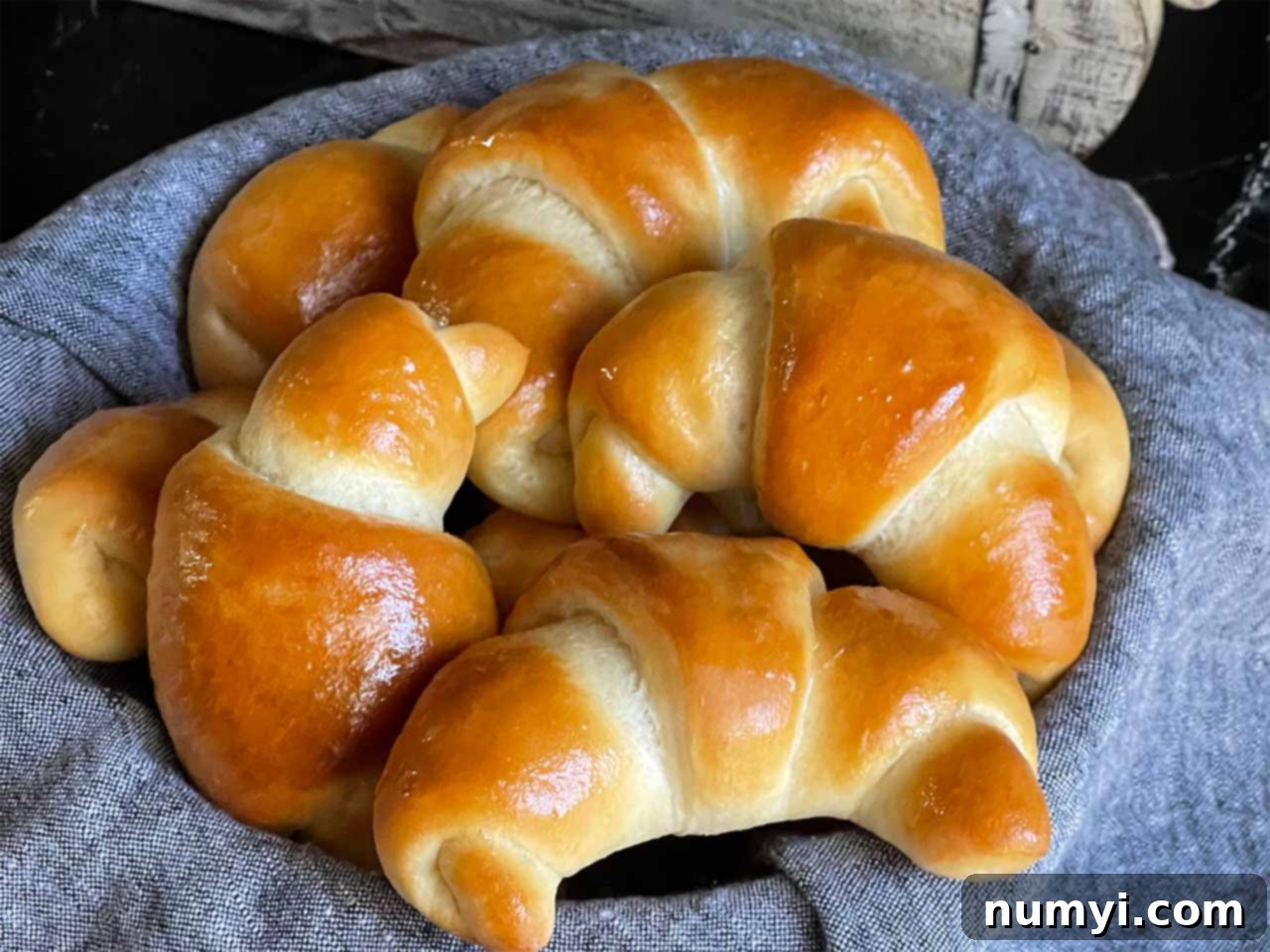The Best Homemade Crescent Rolls Recipe: Fluffy, Buttery, and Easy for Any Occasion
There’s nothing quite like the aroma of freshly baked bread filling your kitchen, and these homemade crescent rolls are no exception. Imagine light, incredibly fluffy, and richly buttery rolls, warm from the oven, ready to grace your dinner table. This easy-to-follow recipe promises delicious results, perfect for a cozy Sunday dinner, a festive Thanksgiving feast, or your cherished Christmas gatherings. Forget the store-bought tubes; these tender, golden crescent rolls offer a superior taste and texture that will impress everyone.
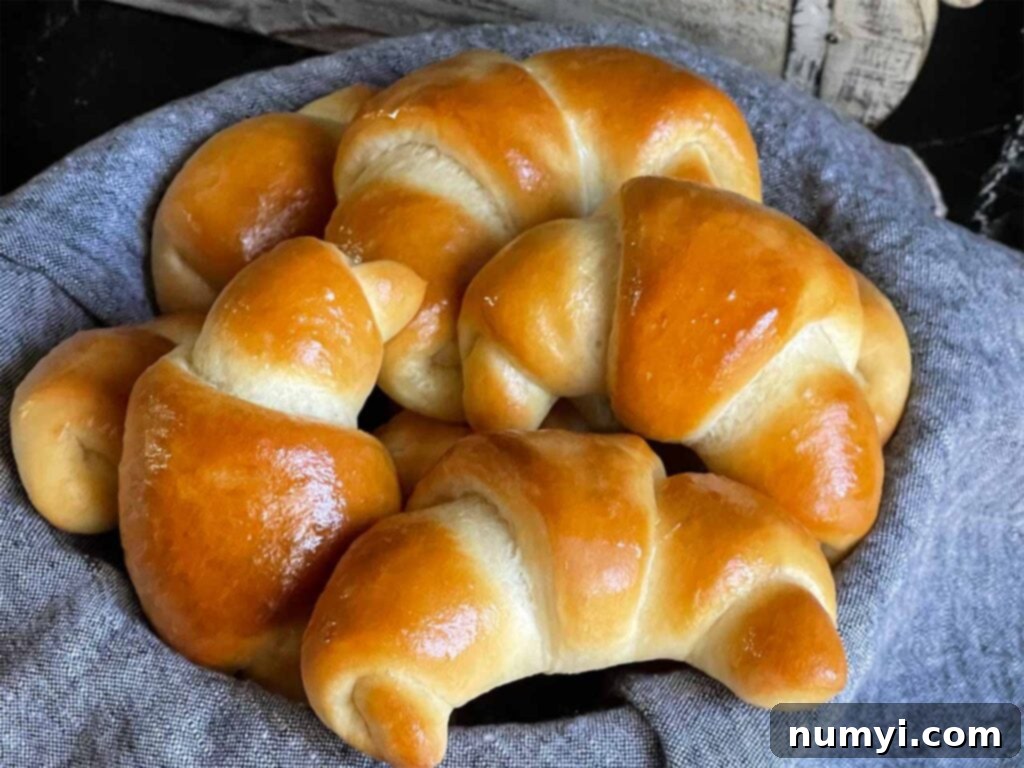
Don’t Sweat The Recipe is supported by its readers. We may earn a commission if you purchase through a link on our site. Learn more.
Why You’ll Adore These Homemade Crescent Rolls
Who can resist the allure of freshly baked homemade crescent rolls? There’s an undeniable magic in pulling a tray of warm, buttery, soft, and richly flavorful rolls straight from your oven to the table. This recipe for easy crescent rolls isn’t just about making bread; it’s about creating a memorable experience and a truly satisfying bite.
- Speedy Satisfaction: Unlike many yeasted breads, these soft, tender crescent rolls can be on your table in under 2 hours, making them ideal for even last-minute dinner plans.
- Pure Bread Bliss: Each roll is a big, billowy pillow of pure fresh bread delight. Their tender crumb and slight chewiness are simply irresistible.
- Convenient Make-Ahead Option: This easy crescent rolls recipe is designed for flexibility. You can prepare the dough in advance, saving precious time on busy days, especially during holiday preparations.
- Superior Taste and Quality: Say goodbye to the bland, dense rolls from a can. This homemade version is significantly tastier, more flavorful, and you have complete control over every wholesome ingredient that goes into them, ensuring the freshest, most delicious outcome.
These versatile rolls are the perfect accompaniment to a wide range of meals. Serve them alongside a hearty garlic herb beef top round roast, succulent smoked double-cut pork chops, creamy chicken thighs with garlic cream sauce, or as an essential part of your lavish holiday dinner spread. Beyond dinner, they’re fantastic for elevated sandwiches, especially with leftover turkey. We also love using them to scoop up our savory chicken salad, making for a truly delightful lunch.

Essential Recipe Ingredients for Perfect Crescent Rolls
Creating these heavenly crescent rolls starts with a few basic, high-quality ingredients. Each component plays a crucial role in achieving that signature fluffy texture and rich, buttery flavor. You’ll need:
- Warm Water: Essential for activating the yeast. Ensure it’s between 105-115°F (40-46°C) – too cold, and the yeast won’t activate; too hot, and you’ll kill it.
- Active Dry Yeast: The leavening agent that makes your rolls rise and become light and airy. Fresh yeast is key for reliable results.
- Whole Milk: Adds richness, tenderness, and a lovely golden hue to the crust. Warm milk also helps activate the yeast.
- Unsalted Butter: Used in the dough for flavor and tenderness, and melted for brushing on the rolls to create those beautiful flaky layers and a golden finish. Unsalted butter allows you to control the overall salt content.
- Granulated Sugar: Feeds the yeast, aiding in its activation and contributing to the rolls’ slight sweetness and golden-brown crust.
- All-Purpose Flour: The structure of your rolls. Measuring accurately is vital for the right consistency.
- Kosher Salt: Balances the flavors and enhances the sweetness, also slowing down yeast activity slightly for better flavor development.
- Large Egg: Adds richness, helps with binding the dough, and contributes to the tender texture and golden color of the baked rolls.
Using these pantry staples, you’re well on your way to baking the most delicious homemade dinner rolls imaginable.
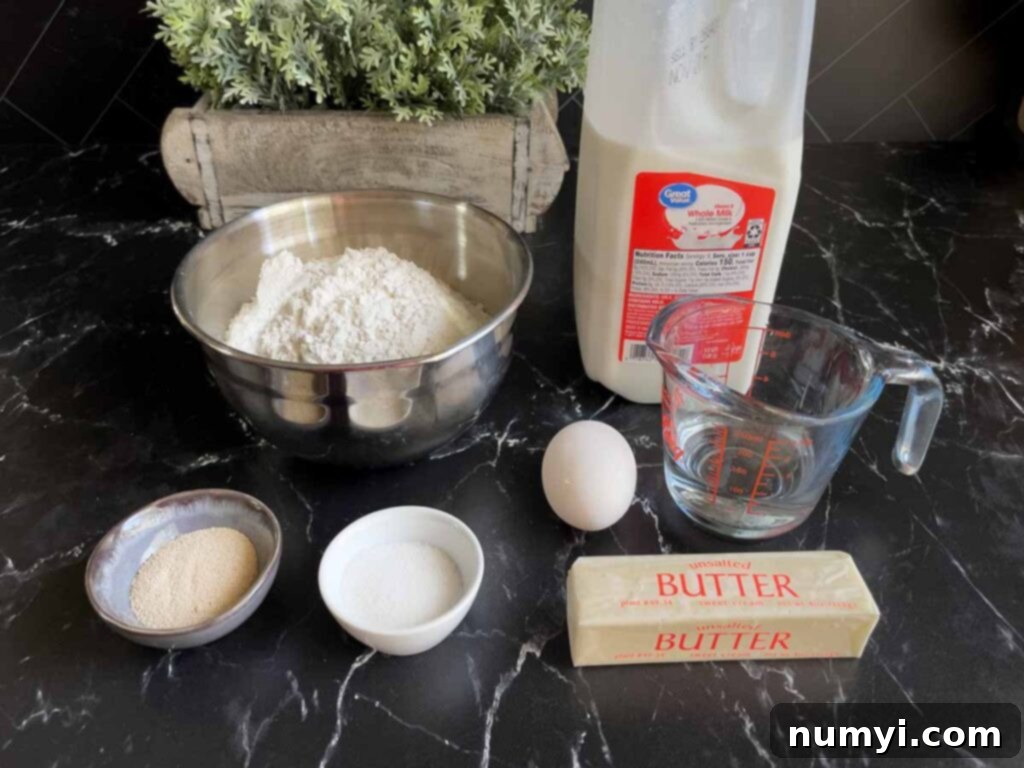
Mastering the Art of Homemade Crescent Rolls: Step-by-Step Guide
Making crescent rolls from scratch is a rewarding process, and surprisingly straightforward with these clear steps. The key is in proper ingredient temperatures and gentle handling of the dough. Let’s get baking!
Preparing the Dough:
Begin by combining the active dry yeast, one tablespoon of granulated sugar, and warm water in the bowl of a stand mixer. The water temperature is crucial here; it needs to be precisely between 105-115°F (40-46°C). This range is perfect for awakening the yeast without killing it. Allow this mixture to proof for 5-10 minutes. You’ll know it’s ready when a foamy layer forms on the surface, indicating the yeast is active and thriving.
While your yeast is proofing, whisk together the all-purpose flour, the remaining tablespoon of sugar, and kosher salt in a separate medium bowl. This ensures even distribution of dry ingredients before they are incorporated into the wet mixture.
Next, in a large glass measuring cup, combine the whole milk and the initial 1/4 cup of unsalted butter. Microwave this mixture in short 30-second intervals until the milk is warm (again, 105-115°F, not hot to touch) and the butter is mostly melted. A few unmelted butter pieces are perfectly fine as they will incorporate into the dough during mixing.
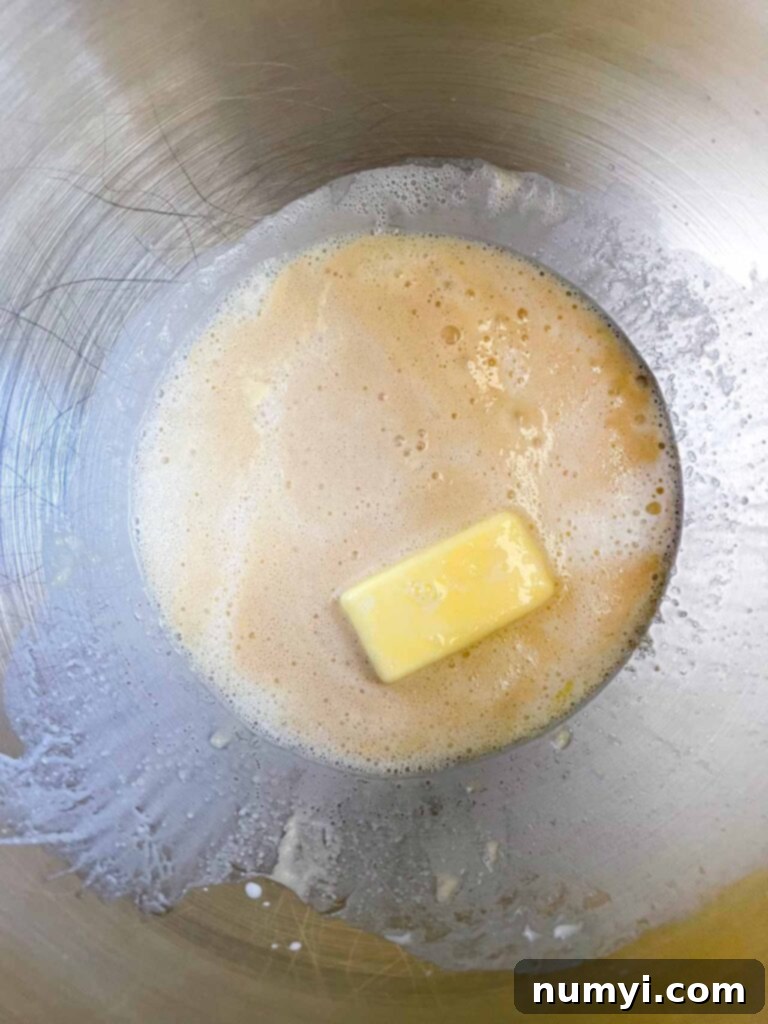
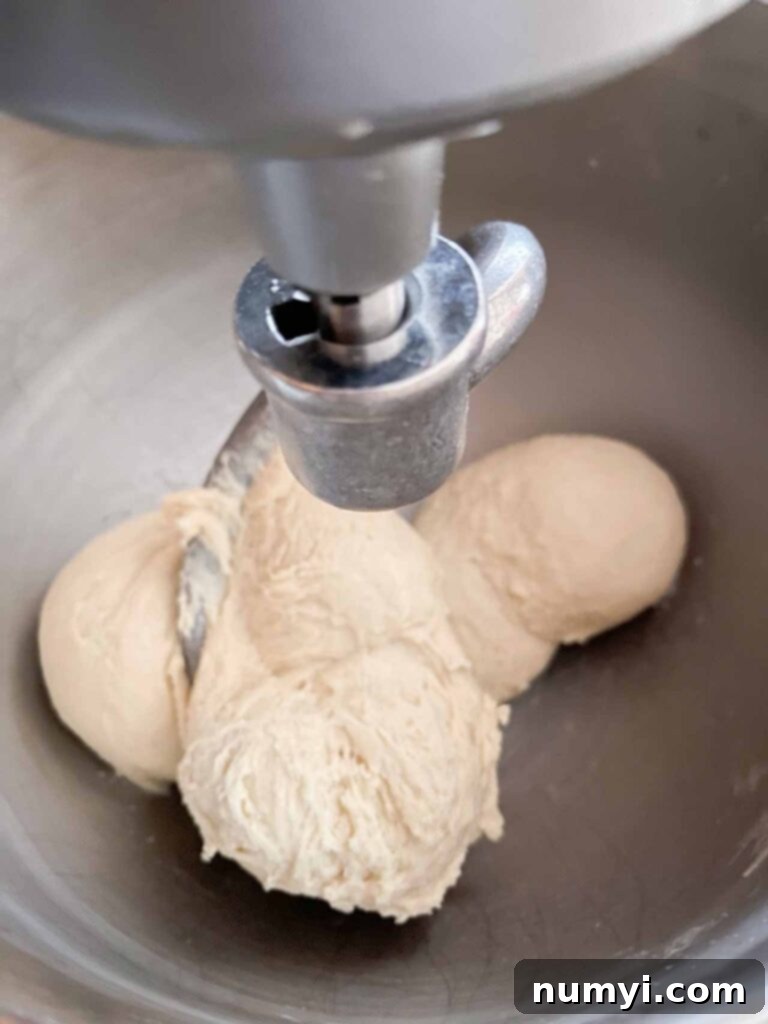
Pour the warm milk and butter mixture into the stand mixer bowl with the proofed yeast. Crack in the large egg and whisk everything together thoroughly until well combined. Now it’s time to add the dry ingredients. With the dough hook attachment, gradually add the flour mixture, about 1 cup at a time, mixing well after each addition until a shaggy dough forms. Once all the flour is incorporated, continue to knead the dough on medium speed for 2 minutes. This brief kneading develops the gluten, giving the rolls their signature chewiness and elasticity.
Once kneaded, remove the dough hook, cover the bowl tightly with plastic wrap, and let the dough rise in a warm, draft-free place for approximately one hour, or until it has visibly doubled in size. This first rise is crucial for developing flavor and creating a light texture.

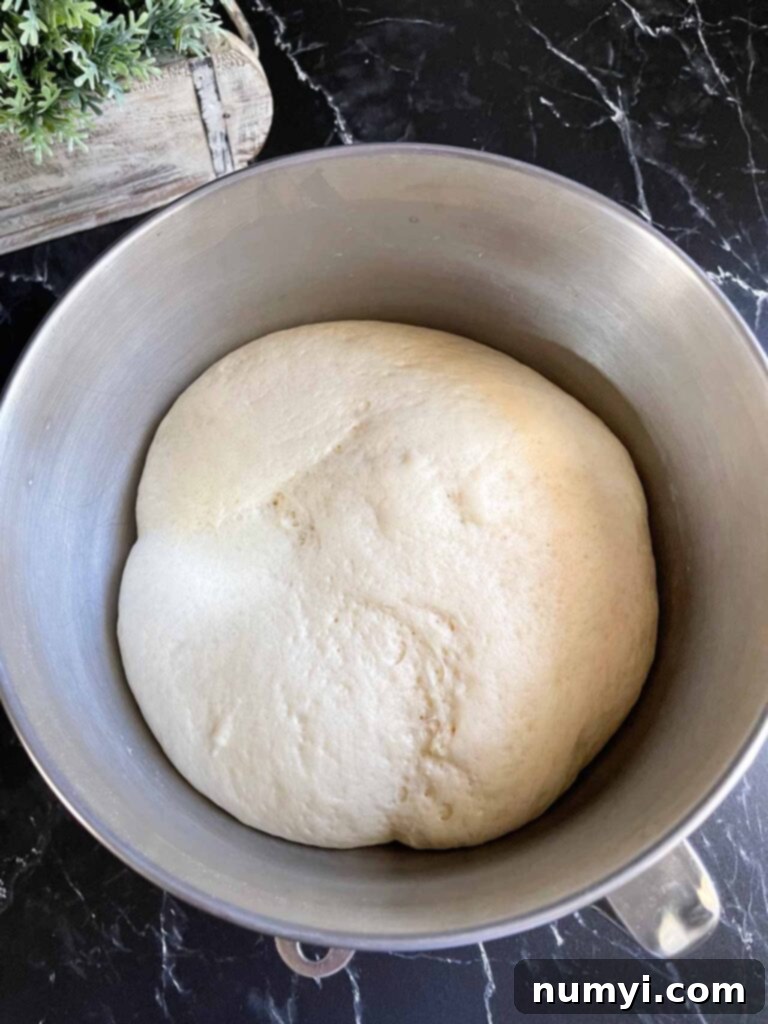
How to Shape and Bake Perfect Crescent Rolls
Once your dough has completed its first rise, it’s time for the fun part: shaping these beautiful rolls! Proper shaping is key to their classic crescent form and flaky texture.
Shaping the Rolls:
First, prepare two baking sheets by lining them with parchment paper. This prevents sticking and makes cleanup a breeze. Gently punch down the risen dough to release the accumulated gases. Scrape the dough out onto a lightly floured work surface. Using a sharp knife or a bench scraper, divide the dough in half. Keep one half covered with plastic wrap or a clean kitchen towel while you work with the first piece to prevent it from drying out.
Take one half of the dough and roll it out into a smooth, even 12-inch circle. The thickness should be consistent for even baking. In a small microwave-safe bowl, melt 1/4 cup of butter. Using a pastry brush, generously coat the entire surface of the rolled-out dough circle with this melted butter. This layer of butter is essential for creating the distinct flaky layers in the crescent rolls.
Now, using a pastry cutter or pizza cutter, slice the buttered dough circle into eight equal triangles, much like you would slice a pizza. For best results, cut the circle into quarters first, then halve each quarter. This ensures more uniform rolls.
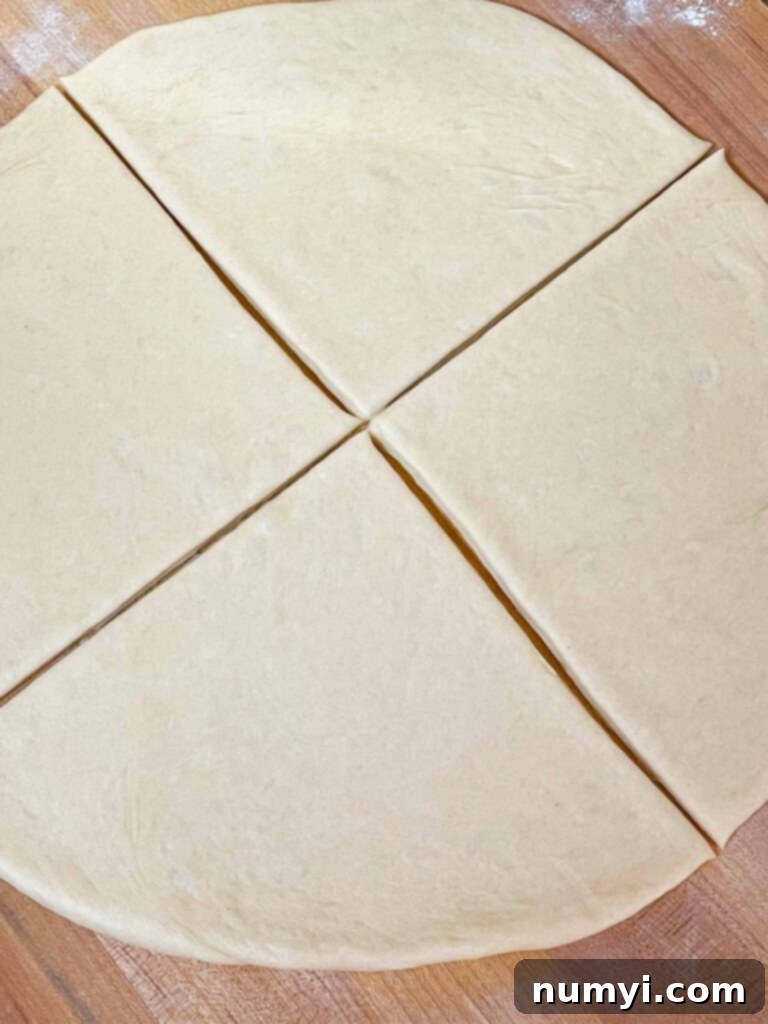
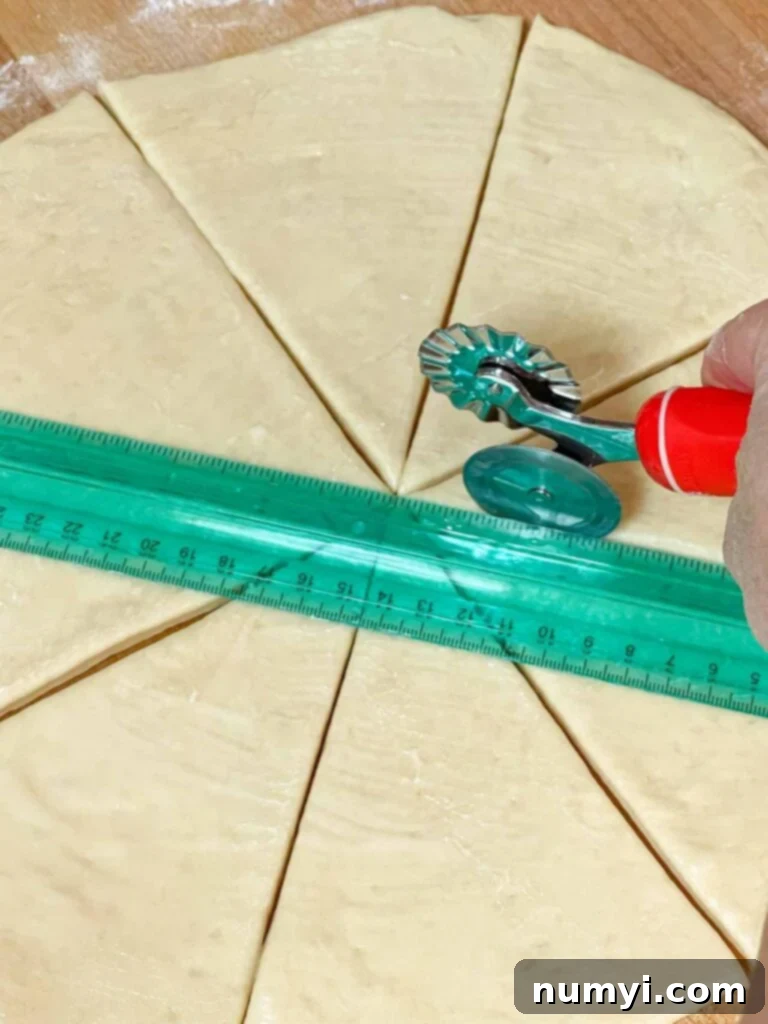
Starting from the wide end of each triangle (the buttered side should be facing up), begin to roll the dough. Roll them somewhat tightly and evenly towards the point to create that classic crescent shape. Place the rolled triangles point-down on your prepared baking pan, ensuring they are about 2 inches apart to allow for expansion during the second rise and baking. Repeat this process with the remaining half of your dough.
Once all the crescent rolls are shaped and on the baking sheets, cover them lightly with greased plastic wrap or a clean kitchen towel. Allow them to rise in a warm place until they have doubled in size, which usually takes about 1 hour. This second rise is crucial for light, airy rolls.
Baking Instructions:
While your crescent rolls are undergoing their final rise, preheat your oven to 375°F (190°C). Once the oven is hot and the rolls have risen, remove the cover and place them in the preheated oven. Bake for 10-12 minutes, or until the tops are beautifully golden brown. The timing may vary slightly depending on your oven, so keep a watchful eye.
For an extra touch of decadence, brush the warm, freshly baked rolls with additional melted butter immediately after they come out of the oven. This adds a lovely sheen and enhances their rich flavor. Serve them warm and enjoy the pure delight of homemade bread!
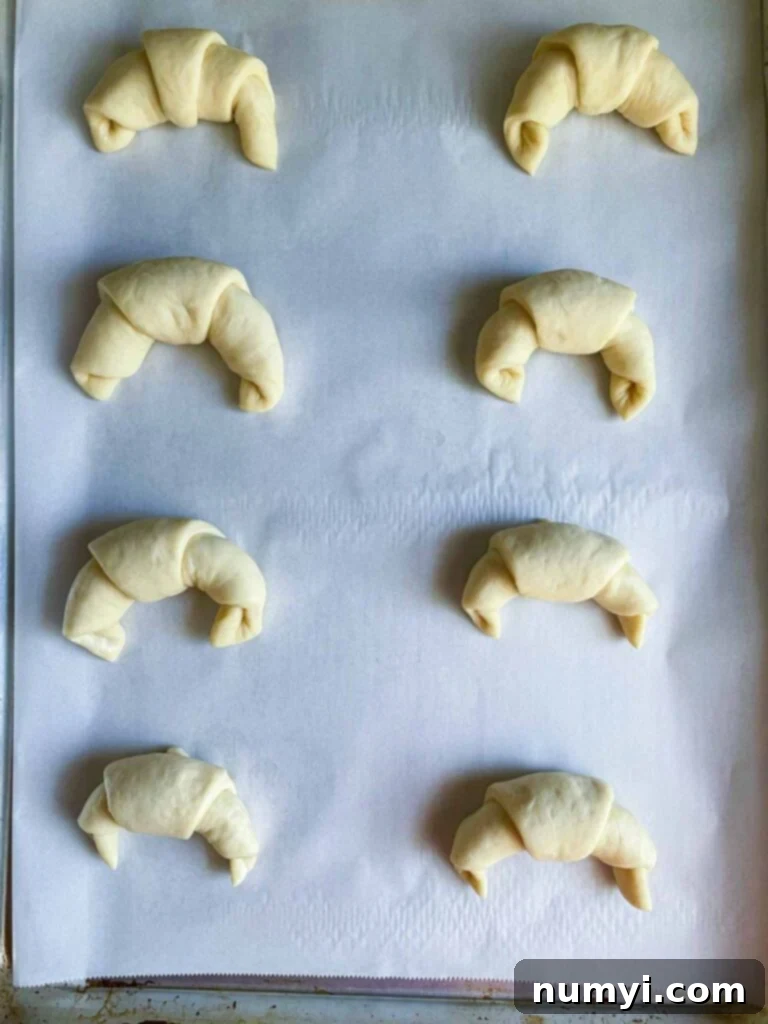
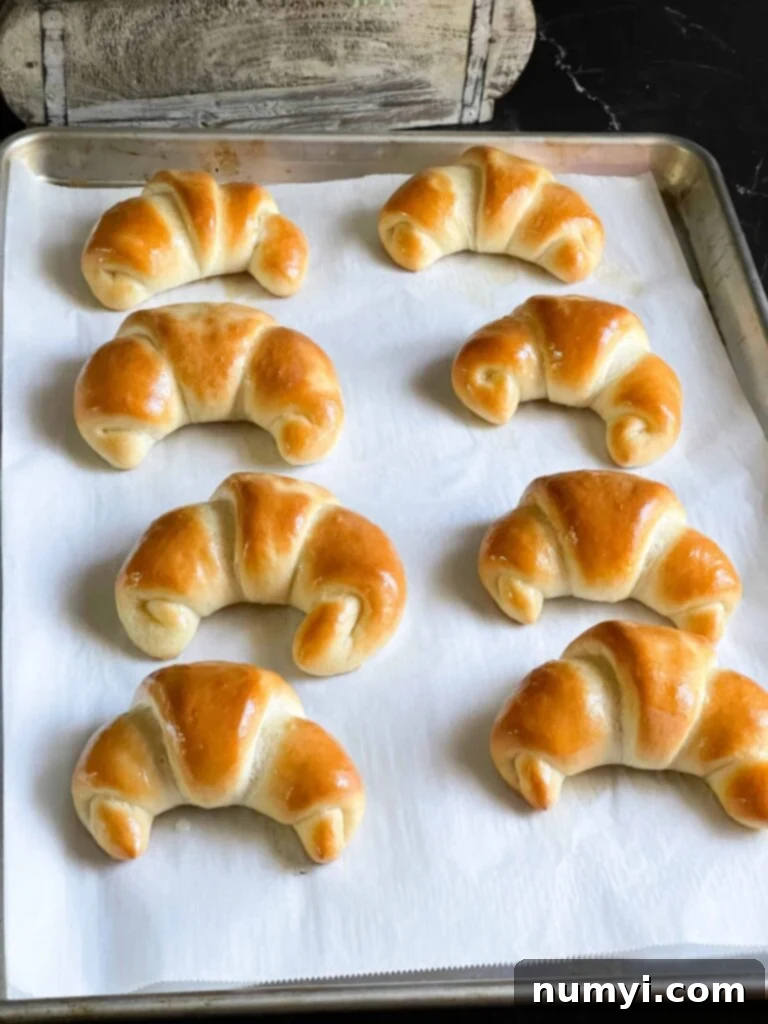
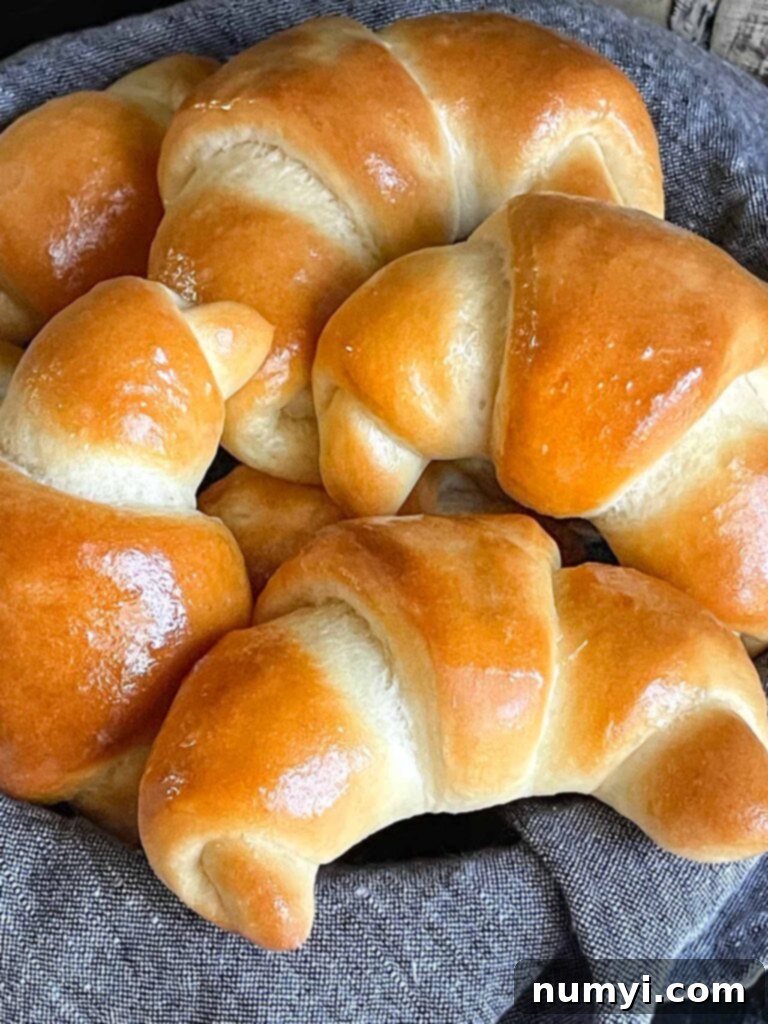
Expert Tips for the Best Homemade Crescent Rolls
Achieving bakery-quality crescent rolls at home is easier than you think, especially with these helpful tips:
- Accurate Flour Measurement is Key: Always measure your flour properly. The best method is to aerate the flour (fluff it up with a spoon), then spoon it lightly into your measuring cup, and finally, swoop the top level with a straight edge. This prevents over-packing, which can lead to dense rolls.
- Don’t Worry About Unmelted Butter: When warming the milk and butter, don’t be concerned if the butter doesn’t melt completely. Small pieces of butter are actually beneficial as they will incorporate into the dough and contribute to a more tender texture.
- Instant Yeast Option: If using instant yeast instead of active dry, there’s no need for the initial “blooming” step. Simply add all the wet ingredients along with the sugar to the stand mixer bowl, then gradually incorporate the flour mixture 1 cup at a time.
- Divide Dough Evenly: This recipe yields approximately 2 pounds of dough. For consistent roll sizes, I highly recommend using a kitchen scale to divide the dough evenly into 1-pound pieces before rolling. This ensures uniform baking.
- The Oven Light Trick for Rising: For a perfect warm and draft-free environment for rising, I often use my oven! Cover the rolls with greased plastic wrap and let them rise in the oven with just the light on. The gentle warmth from the bulb creates an ideal microclimate for yeast activity. Just remember to remove the rolls *before* preheating the oven for baking!
- Watch Your Oven Closely: Every oven has its quirks. Keep a close eye on your crescent rolls during the last few minutes of baking. You want them golden brown, not overly dark, to maintain their tender texture.
Delicious Variations to Elevate Your Crescent Rolls
While classic buttery crescent rolls are a delight on their own, they also serve as a fantastic canvas for creative flavor variations. Here are some ideas to try:
- Egg Wash for a Golden Shine: For a beautifully glossy, deep golden-brown crust, whisk one egg with a tablespoon of water and brush this egg wash over the rolls just before baking. This is a great alternative to brushing with melted butter after baking.
- Sweet Spreads for Breakfast or Dessert: Once baked, slice them open and slather them generously with homemade apple butter, sweet honey butter, or rich Nutella for a delightful breakfast or dessert.
- Make Pigs in a Blanket: A crowd-pleasing appetizer! Simply roll each dough triangle around a cocktail-sized hot dog (or a full-sized one cut in half) before baking. Serve with mustard or ketchup.
- Garlic Butter Crescent Rolls: After brushing the melted butter onto the dough circle, sprinkle it generously with grated Parmesan cheese, garlic powder, and a dash of Italian seasoning. Then cut into triangles, roll, and bake for a savory, aromatic treat.
- Pizza Crescent Rolls: Transform your rolls into mini pizzas! Brush the dough circle with melted butter, then cut into triangles. Before rolling, sprinkle shredded mozzarella cheese and finely diced pepperoni or cooked sausage onto each triangle. Roll them up and bake for a fun, savory snack.
- Cinnamon Sugar Rolls: For a sweet twist, after brushing the dough circle with melted butter, mix granulated sugar with a generous amount of cinnamon in a small bowl. Sprinkle this cinnamon-sugar mixture evenly over the entire surface before cutting into triangles, rolling, and baking.
Frequently Asked Questions About Homemade Crescent Rolls
While both share a similar shape, crescent rolls and croissants are fundamentally different. Crescent rolls are a type of bread, made with a single-rise, enriched yeast dough that is relatively straightforward to prepare. Croissants, on the other hand, are a pastry. They are made from a laminated dough, which involves repeatedly folding butter into the dough to create numerous thin, flaky layers. This lamination process is much more labor-intensive and results in a distinctively crispier, more delicate texture compared to the soft, fluffy interior of a crescent roll.
Absolutely! This recipe is excellent for make-ahead convenience. Prepare the dough through the kneading process. Instead of letting it rise at room temperature, place the kneaded dough in a lightly greased bowl, turning it once to coat. Cover the bowl tightly with plastic wrap and refrigerate it for up to 2 days. When you’re ready to bake, remove the bowl from the refrigerator and let it sit at room temperature for about 1 hour to allow the dough to warm up slightly. Then, proceed with cutting the triangles, rolling them, and placing them on a prepared baking sheet. Cover with greased plastic wrap, let them rise until doubled in size (this might take a bit longer if the dough is still cool), and then bake as instructed.
Freezing formed, unbaked crescent rolls is my preferred method for future enjoyment. Once you have shaped the rolls, arrange them on a parchment paper-lined baking sheet and freeze them until they are completely solid. This step prevents them from sticking together. Once frozen, transfer the solid unbaked rolls to a freezer-safe bag or an airtight container, and they can be stored in the freezer for up to 3 months. When you’re ready to bake, you have two options: either thaw them in the refrigerator overnight, then place them on a parchment-lined baking sheet, cover with oiled plastic wrap, and let them rise until doubled (about 2-3 hours) before baking. Alternatively, you can thaw them at room temperature on the prepared pan, allowing them to rise until doubled in size (this typically takes about 4 hours) before baking as instructed.
To keep your freshly baked crescent rolls at their best, allow them to cool completely after baking. Then, place them in a resealable airtight bag or container. They will stay fresh and soft at room temperature for up to 3 days. If you wish to reheat them, simply pop them into a 325°F (160°C) oven for 5-10 minutes until warmed through and slightly crisp on the outside.
Yes, baked crescent rolls freeze beautifully! Ensure they are completely cool before freezing. Place them in a freezer-safe bag or an airtight container, making sure to remove as much air as possible to prevent freezer burn. For the best quality and texture, consume them within 2 months. When you’re ready to enjoy them, simply thaw them at room temperature or warm them gently in a low oven.
Discover More Delicious Dinner Roll Recipes
If you’ve enjoyed making these homemade crescent rolls, you might love exploring other homemade bread options that are perfect for any meal:
Soft and Fluffy One Hour Dinner Rolls
Cheddar Chive Biscuits
No Knead Skillet Bread
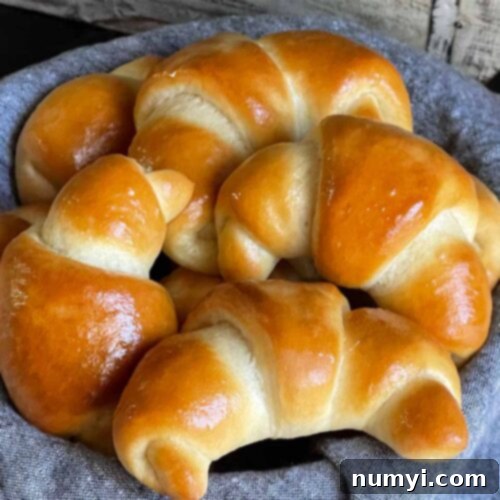
Crescent Rolls Recipe
Print
Pin
Rate
Ingredients
- 1/4 cup Warm water 105-115 degrees F
- 1 tbsp Active dry yeast
- 1 cup Whole milk
- 1/4 cup Unsalted butter
- 2 tbsp Granulated sugar divided
- 3 1/2 cups All-purpose flour
- 1 1/2 tsp Kosher salt
- 1 large Egg
- 1/4 cup Unsalted butter
Instructions
-
In the bowl of a stand mixer, combine the yeast, 1 tablespoon of granulated sugar, and warm water. The water temperature needs to be 105 -115 F. Let the yeast proof for 5-10 minutes until foamy on top.1 tbsp Active dry yeast, 1/4 cup Warm water
-
In a medium-sized bowl whisk the all-purpose flour, remaining tablespoon of sugar, and kosher salt together to combine.2 tbsp Granulated sugar, 3 1/2 cups All-purpose flour, 1 1/2 tsp Kosher salt
-
In a large glass measuring cup add the whole milk and unsalted butter. Microwave in 30-second intervals until the milk is warm 105-115 degrees F(not hot) and the butter is almost melted.1 cup Whole milk, 1/4 cup Unsalted butter
-
Add the milk mixture to the bowl of the stand mixer. Add the egg and whisk well.1 large Egg
-
Using the dough hook, add the flour 1 cup at a time, and mix well. Then knead for 2 minutes. Remove the dough hook, cover the bowl with plastic wrap, and let rise for one hour.
-
Line two baking sheets with parchment paper.
-
Punch down the dough. Scrape the dough out onto a lightly floured work surface. Use a sharp knife to divide the dough in half. Place one half on the work surface, and cover the other piece while you are working with the first piece so it doesn’t dry out.
-
Roll the dough into a 12-inch circle. Melt 1/4 cup of butter in a small bowl. Brush a layer of melted butter over the surface of the dough circle. Using a pastry cutter or pizza cutter, cut the dough (like a pizza) into 8 equal triangles.1/4 cup Unsalted butter
-
Starting with the wide end of each triangle (butter side up), roll the triangle. Roll them somewhat tightly. Place them point down on the prepared baking pan about 2 inches.
-
Continue with the remaining dough. Cover and let rise in a warm place until doubled in size, about 1 hour.
-
Preheat the oven to 375 degrees F while the crescent rolls are rising.
-
Bake for 10-12 minutes, until the tops are golden brown. Brush with melted butter, if desired.
Notes
Instant yeast can be used instead of active dry. There is no need to bloom instant yeast, add all the wet ingredients along with the sugar to the bowl, then add the flour mixture 1 cup at a time.
This crescent roll recipe makes 2 lbs of dough. I use a kitchen scale to divide the dough evenly into 1 lb pieces.
Make Ahead – Make the dough through the kneaded process, place it in a greased bowl, turn it to coat, cover it with plastic wrap, and refrigerate for up to 2 days.
When ready to bake remove the bowl from the refrigerator for about 1 hour, cut the triangles, roll, and place on a prepared baking sheet. Cover with a greased sheet of plastic wrap, let rise until doubled, then bake.
Freezing Formed, Unbaked Crescent Rolls – Form the rolls, place them on a parchment paper-lined baking sheet, and freeze until solid. Place the frozen unbaked rolls in a freezer-safe bag or container and freeze for up to 3 months.
When ready to bake, thaw in the refrigerator overnight, place on a parchment paper-lined baking sheet, cover with a sheet of oiled plastic wrap and let rise until doubled in size, 2-3 hours. Bake as instructed.
Or you can thaw them at room temperature on the prepared pan, let them rise until doubled in size (about 4 hours) and bake.
Storing and Freezing – Let the rolls cool completely, place a resealable bag and store it at room temperature for up to 3 days. Reheat in a 325 F oven for 5-10 minutes. Or you can place them in a freezer-safe bag or container, and freeze them for up to 2 months for the best quality.
Nutrition
This recipe was inspired by the fantastic creation from The Food Charlatan, a true testament to the joy of baking!
